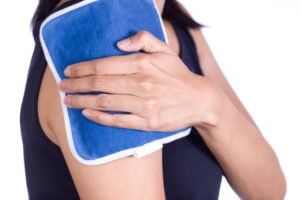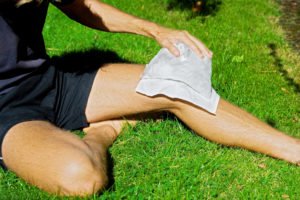
2025-11-21T14:10:25
How to Prevent Gestational Diabetes
- Family Medicine
- Internal Medicine
- OB/GYN
September 5, 2016 | Family Medicine • Hand, Wrist and Elbow Center • Pain Management (Physiatry) • Sports Fitness and Physical Therapy
Specialties:Family Medicine • Pain Management • Sports Fitness and Physical Therapy

For some, muscle soreness is the sign of a great workout, but for others is a major deterrent from returning to the gym. Regardless of fitness level, most people have experienced muscle soreness as a result of strenuous activity. Some level of ‘burning’ or discomfort is a good sign for those trying to increase physical fitness as this soreness shows that muscles are being put under greater stress than they are usually exposed to, which results in muscle growth.
With acute muscle pain, it is best to apply ice, which helps to numb the injury and slow down blood flow to the sore area. Ice is a temporary pain reliever which helps reduce information, but will not treat the underlying causes of the pain. The Mayo Clinic recommends icing for about 20 minutes several times a day.
Effective ways to ice sore muscles include:
Ice pack applied to sore area
An ice bath
Frozen peas in a bag
A towel that has been dampened with cold water and placed in the freezer for 15 minutes
Heat is an ideal treatment for delayed onset muscle soreness (DOMS) as it helps sore and tight muscles relax while increasing the flow of blood to the area of soreness. It is advised that heat be applied in roughly 20-minute increments several times a day.
After introducing a new exercise, many people experience DOMS in several different parts of their body, so a full body application such as a hot bath may work better than isolated therapy such as a heat pad.
 Popular ways to heat muscle include:
Popular ways to heat muscle include:
Heat pack
Heat wrap
Warm bath or hot tub
Saunas
Hot water bottle
Hot shower
Stretching is an important part of a healthy lifestyle that is often overlooked and can help reduce muscle pain.
“Before your workout, an extended warm-up and stretch routine will fully prepare your body for exercise and reduce the effects of DOMS,” Samantha Clayton, certified personal trainer, Olympic sprinter, and women’s sprints coach at Pepperdine University in Malibu, California, says.
Clayton advises that people looking to avoid or lessen the effects of DOMS do “gentle dynamic stretches” which involve movement such as swinging your arms or walking lunges before working out and static stretches which you hold after a workout.
The Mayo Clinic recommends stretching a minimum of two to three times a week, holding most stretches for about 30 seconds and 60 seconds in tense areas. Make sure to bre
ath normally during your stretching and try to avoid ‘bouncing’, which can potentially cause injury.
Some useful static stretches include:
Toe touchesShoulder stretch (lift one arm up, bend it at the elbow, and use your opposite hand to pull the elbow) Quad stretches (stand on one foot and pull one foot towards your butt, stretching the quad)
Dynamic stretches that may reduce pain include:
Alternate toe touch (stand with your feet apart and alternate touching your right hand to your left foot and touching your left hand to your right foot)
Walking lunge
Squats
Skipping
While soreness after working out is a very normal occurrence, sharp persistent pain could be a sign of an injury. Pain that is constant, increases with time, wakes you from your sleep and does not go away is not normal muscle soreness. If you think that you may have an injury, you should seek the care of your physician immediately.

WRITTEN BY:
The Live Better Team

2025-11-21T14:10:25

2025-11-03T11:32:24

2025-10-21T11:51:52

2025-08-20T16:07:59
This information is not intended to replace the advice of a medical professional. You should always consult your doctor before making decisions about your health.